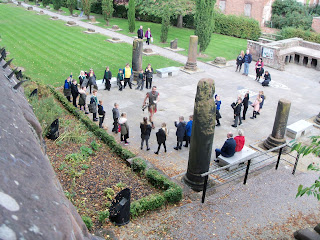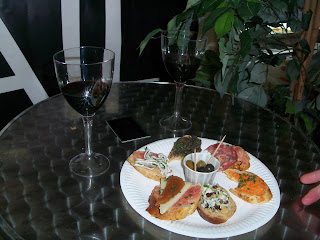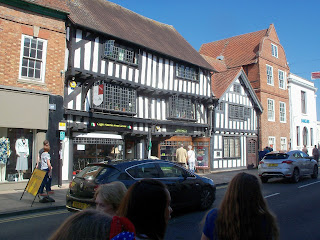Chester and York
Leanne had a dinner meeting in Chester on
Thursday night so I met up with her there on Friday. It was a 3/4 mile walk
from the train station to the hotel Leanne was staying at, on the way there
were a few sights to see. The first thing I saw were the Public Bath on (what
else) Bath street. They are two pools one for diving and one for competitive
swimming and water polo.
After that I walked by an old (of course its
“old”) Roman amphitheater. The
amphitheatre,
which was built in the 1st century, could seat between 8,000 and 10,000 people.
It is the largest known military amphitheatre in Britain.
In and around the
amphitheatre there were school kids that must have been doing day trips here.
The guides were dressed like Roman soldier and the kids (3rd to 5th
grade) were given plastic roman shields. The guide would have them march around
and explain what it was like to be in the roman army. It was a very interesting
history lesson.
A nice
walk around town and I finally got to the hotel and met up with Leanne. From
our hotel room we could see the horse racing track. This track is according to official records is the oldest racecourse still in use in England. It dates
back to the 16th century, the first recorded race was held February
9 1539.
From the hotel we started our walk of the Chester wall. The wall was started in 70 AD and the circuit was completed in the 12th century. The wall is 2 miles long and was a nice start of our day.
The walls were heavily damaged during the siege of the city by Parliamentarian forces in 1645, this included two major breaches. The difference in the stone work shows where the walls were repaired.
Along the wall is the Eastgate clock, the most photographed clock in England
after Big Ben.
After the walk we stopped in the middle of town for a light lunch at a French restaurant. Well we thought it was going to be a light lunch. We decide to go with a light dinner instead. The French restaurant was on a “Rows” street. They have shops on two floors with a walkway for both.
And then there was black-and-white buildings. Called that because they are black and white.
As you can see the wood work is amazing.
After a lot of walking we took a break and i thought it would be a good time to ice the feet. We did not use these for our wine.
Morning breakfast with a view of the race course. We tried black pudding and did not care for it.
For the train
ride from Chester to York we would stop at about 15 towns and have to switch
trains in Manchester. Most of the towns were very small so it was nice to see a
different side of England.
We would get to York at about 1:00 pm, drop what luggage we had at the hotel and start exploring. York was having a food and ale festival, so we scored again with the food. First stop was the Jorvik Viking museum. We seem to be learning more every trip about England, the Vikings had conquered over half of England from 793 AD to 900 AD. Between 1974 and 1981 over 40,000 artifacts were discovered in downtown York.
We would get to York at about 1:00 pm, drop what luggage we had at the hotel and start exploring. York was having a food and ale festival, so we scored again with the food. First stop was the Jorvik Viking museum. We seem to be learning more every trip about England, the Vikings had conquered over half of England from 793 AD to 900 AD. Between 1974 and 1981 over 40,000 artifacts were discovered in downtown York.
From there it
was time to get something to eat and drink. We bought a bottle of Portuguese
wine and then bought a wheel of tapas. The wheel of tapas had 6 different kinds
to try, one was baby eel. The first bite was a little difficult but had no
problem with the rest of it.
We also had Yorkshire
pudding. For most of us that are not English it’s not the pudding you’re
thinking of. Yorkshire pudding is made with flour eggs and a little milk and
poured in a pan of meat drippings and put in the oven to cook. They added meat
to the one we got, it was very, very good!!
Next stop was
the Minster, the largest Gothic church this side of the Alps.
Some of the stain glass dates back to the 12th century. This wall of glass was made in 1260 and has over 100,000 pieces of glass,
The west window built in 1338
outside view
Choir area
There is a building connected to the main building called the Chapter house. The traditional meeting place of the governing body (or chapter)
Sculptured heads above the canopies, representing some of the finest Gothic sculpture in the country. There are human heads, no two alike, and some pulling faces; angels; animals and grotesques. They date back to 1280.
The one stain glass wall we wanted to see was the east wall. There are 311 panels that are scenes from the bible and is the size of a tennis court. It was out getting cleaned the day we were there. They are doing a major restoration of the window and it had been completely dismantled. The Glass was being cleaned (they had a picture of they using Q-tips to clean the glass) and restore any color to it. They also have to replace up to 3,500 stones that hold the panels in place.
We left the Minster and walked to a street called the Shambles, and the way the buildings looked it fit the road perfectly.
https://en.wikipedia.org/wiki/The_Shambles
This house was built in 1316, note the height of the door way. I think there were a lot of short people in the 1300's.
Another house with a lean, maybe a trip to the pub will help with the lean.
York also has a wall that went around the city. Some of the wall has been torn down but we were able to walk about a mile on this section.
The last bit of history we saw is Cliffords Tower.
http://www.english-heritage.org.uk/visit/places/cliffords-tower-york/history/
Kind of surprising they even let us walk around the walls, as you can see its old. The tower was part of York castle and long ago there was a moat around it.
After that it would be another train ride home, it was a great weekend.


































































